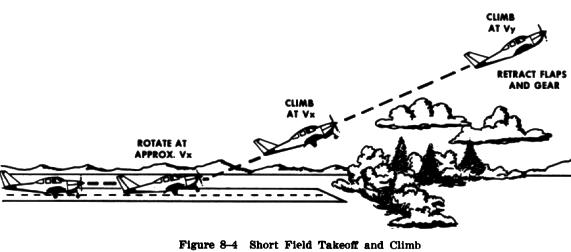
Taking off and climbing from fields where the takeoff area is short or the available takeoff area is restricted by obstructions, requires that the pilot operate the airplane at the limit of its takeoff performance capabilities. To depart such an area safely, the pilot must exercise positive and precise control of airplane attitude and airspeed so that takeoff and climb performance results in the shortest ground roll and the steepest angle of climb.
The result achieved should be consistent with the flight performance section of the FAA approved Airplane Flight Manual or the Pilot's Operating Handbook. In all cases the power setting, flap setting, airspeed, and procedures prescribed by the airplane's manufacturer should be observed.
In order to accomplish maximum performance takeoff safely, the pilot must be well indoctrinated in the use and effectiveness of the best angle of climb speed (Vx) and best rate of climb speed (Vy) for the specific make and model of airplane being flown.
The speed for best angle of climb (Vx) is that which will result in the greatest gain in altitude for a given distance over the ground. It is usually slightly less than the speed for best rate of climb (Vy) which provides the greatest gain in altitude per unit of time. The specific speeds to be used for a given airplane are stated in the FAA approved Airplane Flight Manual or the Pilot's Operating Handbook. It will be found that in some airplanes, a deviation of 5 knots from the recommended speed will result in a significant reduction of climb performance. That being the case, precise control of airspeed has an important bearing on the safety of the operation.
Taking off from short fields requires that the takeoff be started from the very beginning of the takeoff area and the airplane accelerated as rapidly as possible. At the field threshold, the airplane is aligned with the intended takeoff path and maximum allowable power applied promptly while releasing the brakes. If the use of flaps is recommended by the airplane manufacturer, they should be extended the proper amount before starting the takeoff roll. This permits the pilot to give full attention to the proper technique and the airplane's performance throughout the takeoff. There is no significant advantage to extending flaps just prior to liftoff.
Takeoff power should be applied smoothly and continuously - there can be no hesitation - to accelerate the airplane as rapidly as possible. As the takeoff roll progresses, the airplane's pitch attitude and angle of attack should be adjusted to that which results in the minimum amount of drag and the quickest acceleration (Fig. 8-4). In nosewheel type airplanes this will involve very little use of the elevator control, since the airplane is already in a low drag attitude. In tailwheel type airplanes, the tail should be allowed to rise off the ground slightly, then held in this tail low flight attitude until the proper liftoff or rotation airspeed is attained.

For the steepest climb out and best obstacle clearance, the airplane should be allowed to roll with its full weight on the main wheels and accelerated to the liftoff speed. The airplane should be smoothly and firmly lifted off, or rotated, by applying back pressure on the elevator control as the best angle of climb speed (Vx) is attained. Since the airplane will accelerate more rapidly after liftoff, additional back pressure becomes necessary to hold a constant airspeed. After becoming airborne, a straight climb should be maintained at the best angle of climb speed (Vx) until the obstacles have been cleared or, if no obstacles are involved, until an altitude of at least 50 feet above the takeoff surface is attained. Thereafter the pitch attitude may be lowered slightly, and the climb continued at the best rate of climb speed (Vy) until reaching a safe maneuvering altitude. Unlike a short field approach where the power can be varied to maintain the desired approach airspeed, the short field takeoff requires the use of full takeoff power. Since the power setting is thereby fixed, airspeed must be controlled by adjusting the pitch attitude which in turn will also vary the climb angle. Remember that an attempt to pull the airplane off the ground prematurely, or to climb too steeply, may cause the airplane to settle back to the runway or into the obstacles.
On short field takeoffs, the flaps and landing gear should remain in takeoff position until well clear of obstacles (or as recommended by the manufacturer) and the best rate of climb speed (Vy) has been established. It is generally unwise for the pilot to be looking in the cockpit or reaching for flap and landing gear controls, until obstacle clearance is assured. When the best rate of climb speed has stabilized, retraction of the flaps may be started. It is usually advisable to raise the flaps in increments to avoid sudden loss of lift and settling of the airplane. After the flaps are fully retracted, the landing gear should be retracted (if so equipped) and the power reduced to the normal climb setting.